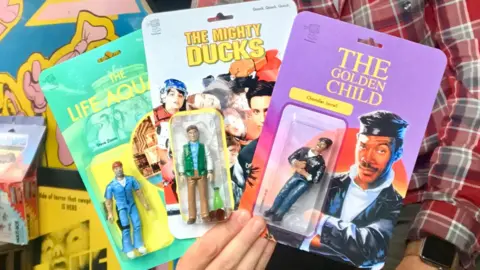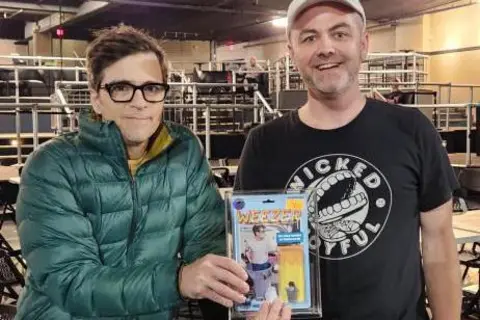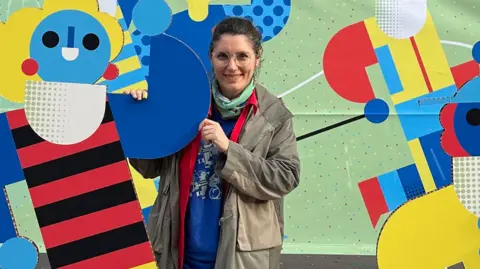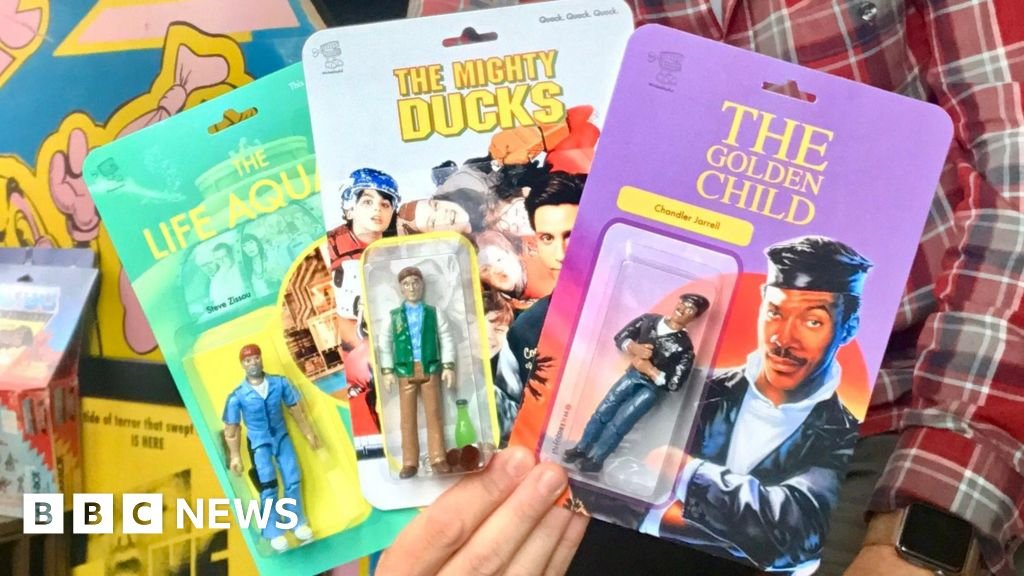BBC News
 Wicked Joyful
Wicked JoyfulArtists and creatives are pushing back against a recent trend using artificial intelligence (AI) to generate “starter pack” images of people as toys – which they say may be in danger of risking their livelihoods.
Since the start of April, thousands of people have uploaded their photos to generate images of themselves as dolls, despite warnings of damaging the environment, giving away personal information, and devaluing creativity.
Nick Lavellee, who has made custom action figures for six years, told the BBC he was concerned his work may be at risk after “AI images saturated social media”.
“People are sick of them,” he said. “It’s an artistic aesthetic – AI-generated art diminishes that.”
Nick has made figures of – and for – comedians, film directors, and artists such as Weezer and Tyler Childers, which sell for as much as $250 (£188) online on his Wicked Joyful website.
His success has led to a clothing brand and will soon be followed by a physical shop in his hometown of Manchester, New Hampshire.
But he’s concerned action figure commissions could soon dry up, as well as the public perception of his work, from thousands of AI images mimicking his passion.
 Wicked Joyful
Wicked JoyfulThe feeling has been shared by other creatives with the rise of the #StarterPackNoAI movement, which has been used thousands of times since first appearing on Instagram in early April before spreading to X soon after.
Allow Instagram content?
After Patouret’s post, others quickly joined the counter-trend, with artist Maria Picassó Piquer saying she chose to take part “for fun, but also as a statement”.
“While AI pieces all looked more or less the same, I was amazed at the variety of the ‘human’ works,” she said.
 Maria Picassó Piquer
Maria Picassó Piquer“Plus, self-portraits added an extra layer of, well, humanity.”
Maria, like many other artists, sees the dual risk of AI images threatening intellectual property rights by being “fed on ‘stolen’ art”, and the possibility of reducing her finding new clients.
Allow Instagram content?
Illustrator Dav le Dessineux, working in Bordeaux, France, said some in his industry had already lost contracts to AI design work.
He contributed his starter pack because “like many artists who use their real hands”, he was “tired” of the deluge of AI-generated doll images.
Dav’s illustration featured only a pencil and sheet of white paper – tools he said are “all you need to start being an artist”.
Allow Instagram content?
“People usually forget about it because of the technology surrounding us, but we really don’t need more than basic stuff to create something and be original,” he said.
Eli Dibitonto, an artist living in Barletta, Italy, agreed, describing the process of digitally illustrating his own starter pack as “carefree and fun”.
“It doesn’t have to be perfect – mine isn’t,” he said. “Art isn’t meant to be perfect or look flawless.”
Allow Instagram content?
And illustrator and student Evie Joyce said creating her own artwork meant being able to consider what to reflect of her personality during a process lasting several hours, rather than seconds.
“I think that what’s so magical about it is you’re seeing people put time and effort and their personality, all of their experiences, into pieces of art,” she said.
“With AI, it can even steal from artists and steal their work and their style, it just loses that touch of personality.”
Allow Instagram content?
Pot Noodles in the Large Hadron Collider
Back in New Hampshire, Nick understands the rebellion from illustrators, but says he believes there is use for AI.
“I don’t necessarily want to say AI is bad when I know that it could be a useful tool,” he said.
“I think all of us have experimented with it.”
Allow Instagram content?
And Henk van Ess, a global expert in using AI in investigative research, has proven how useful it can be – but it would be safe to say he does not believe it lies in starter packs.
“It’s like watching a supercomputer calculate how many Hobnobs fit in a Sports Direct mug, while solving climate change sits on the ‘to-do’ list,” he said.
“Technically impressive? Sure. But it’s the technological equivalent of using the Large Hadron Collider to heat up your Pot Noodle.
“While everyone’s busy generating these digital equivalents of small talk, they’re missing the actually revolutionary stuff AI can do – it’s just wasteful to put all that energy into creating digital fluff when we can use it for solving real-world problems.”
Call on the cabinetmakers
And Nick remains positive.
“The musicians who get my stuff, who are excited to hold a Wicked Joyful in their hands, they know it’s my artwork, they know it’s mine,” he said.
Likewise, Dav is confident in the worth of human work.
Despite the rise of pre-fabricated furniture, he says, “people still call on cabinetmakers”.
“I hope I’ll be one of those artisans,” he said.
Nick, who says he found his purpose “in bringing joy to people” with his creations, said he similarly wanted to remain hopeful about the future.
“I really hope people are totally sick of AI action figures,” he said.
“But I hope that they are smart enough to understand the difference in something that I’m doing versus what is computer-generated.”





